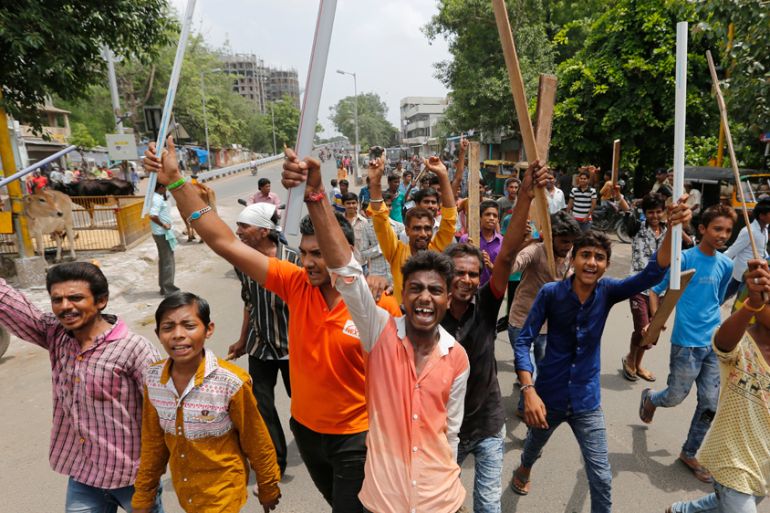Sacred cows and India’s caste carcass
Demonstrations are growing in Gujarat state with Dalits leaving dead cows at government offices after caste beatings.

This story unfolds in many ways and in many simultaneous forms.
When the powerful new film Sairat was released, few referred to a “silent” revolution brewing among India’s lower castes.
Keep reading
list of 4 itemsPhotos: Ukraine marks its third Easter at war
Israeli police detain Greek consul’s guard at Orthodox Easter ceremony
Gunman kills at least six in attack on mosque in Afghanistan’s Herat
The film in the regional Indian-language Marathi, with a newcomer cast, shocked audiences and pundits alike by becoming the biggest Marathi grosser in the central Indian state of Maharashtra.
The story of Sairat is that of a Dalit boy’s struggle against caste oppression. The film depicts the honour killings of young couples for marrying outside their caste.
In the rural hinterlands of India, the khap panchayats (traditional community organisations) still mete out their own forms of justice to “erring” villagers.
In the film, the “hero” loses his life but the movie ends up a big winner.
Arrests made after Dalit children burned alive in India
While basking in the glory of the success, film-maker Nagraj Manjule, in Indian TV interviews, has repeatedly referred to the events surrounding the tragic death of an Indian scholar Rohith Vemula.
|
|
| India’s Dalit lack trust in coming elections |
In January this year, the young Dalit academic killed himself after he was suspended from university, in a case many have blamed on caste-related discrimination. Vemula’s death sparked fiery protests across the country.
For the benefit of those who do not understand India’s brutal and oppressive caste system, here is a ready reckoner:
The Dalit, formerly known as “untouchables”, are frequently the victims of violence and prejudice across Indian states.
There are about 180 million Dalits in India’s 1.25 billion population.
The origins of the caste system trace back to the Hindu religious text, the Manusmriti.
The 2016 film Sairat is based on caste politics of the state of Maharashtra, where Bhimrao Ambedkar, the Dalit icon and the architect of India’s constitution, was cremated.
Young Dalit scholar Rohith Vemula ended his life in the southern part of India, which has had its share of caste conflict.
But by the time the story reached the western Indian state of Gujarat, described by many as the laboratory of experiments for the Hindu nationalist organisation RSS (Rashtriya Swamyamsewak Sangh), the narrative had taken a different form.
Dramatic visuals, photos and videos, have emerged on Indian social media sites and on TV news channels of growing protests by Dalit groups across Gujarat over the past few days.
Media reports say the unrest is spreading across towns and cities throughout the state, the home state of India’s Prime Minister Narendra Modi.
These protests have taken place after last week’s assault on four Dalit men, allegedly by the members of a Hindu hardline group.
These Dalit men, who were trying to skin a dead cow, were bound, stripped, beaten with sticks by men claiming to be “cow protectors”, and then dragged by a vehicle in Una, a town a few hundred of kilometres away from the capital city of Ahmedabad.

Disparate cow protector groups have sprung up to dispense mob justice across northern and western states of India in a shocking breakdown of law and order.
It was the latest in a series of violent cow-related incidents that have once again highlighted the problems and discrimination linked to caste and communities. Last year, a Muslim man, Mohammed Akhlaq, was beaten to death by a Hindu mob in his home for allegedly killing a cow in his village.
On Tuesday, enraged Dalit protesters left cow carcasses in buildings and compounds of Indian government offices. They were making a point to state that they would no longer do tannery work, traditionally seen as a job for lower castes and Dalits.
The cow, revered by Indian upper caste Hindus as a Mata (mother), has been used to spur hate against religious and other minorities such as Muslims and Dalits. Killing or consuming cow meat is a religious taboo for pious upper caste Hindus.
Dalit handles on Twitter posted pictures and videos of protesters.
Along with images of cow corpses were slogans that read “Yeh hai tumhaari maata. Tum karo antim sanskaar” (Here lies your mother, you do the last rites).
Meanwhile, an AFP report said a police officer was killed and several others were wounded during violent clashes on Tuesday.
Gujarat is already battling chaotic protests by a powerful upper caste clan that wants reservations in government jobs for their people, the Patels.
This lays bare the claims by many sociologists that the rapid urbanisation of India has weakened the caste system.
The new Dalit uprising in the world’s largest democracy is yet to appoint its “leaders”. Just like the film Sairat is brought to life by newcomers, the Dalit consciousness movement is playing out a new resistance script.
|
|
| Al Jazeera World – Dalit Muslims of India |